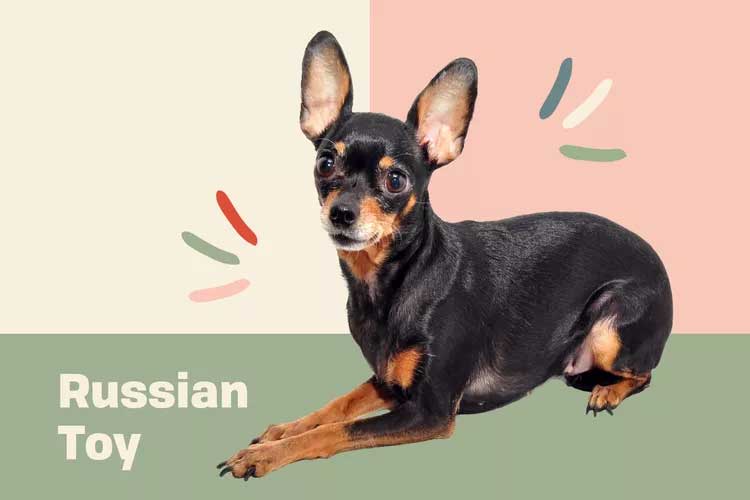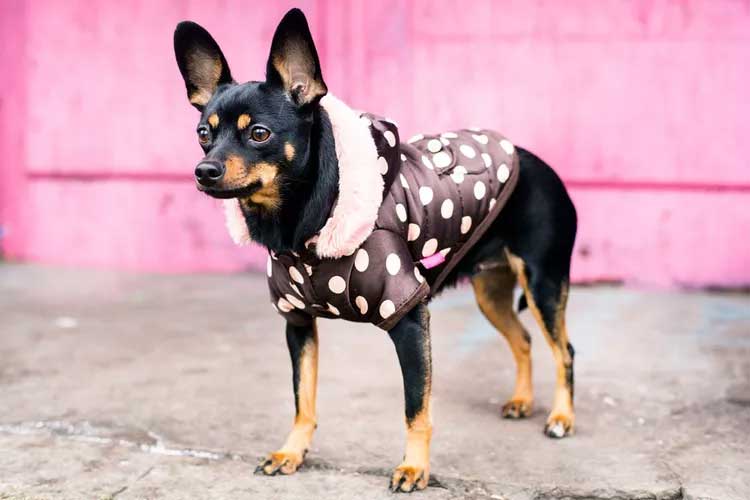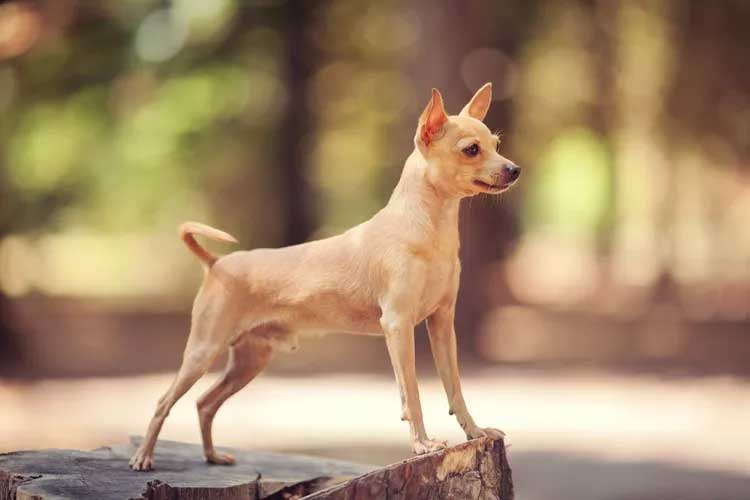Once companions for Russian aristocrats, Russian toy dogs today are playful, affectionate pets. They may be among the tiniest breeds, but they’re courageous and clever.

Russian Toy Overview
| OFFICIAL NAME | Russian Toy |
| COMMON NAME | Russian Toy |
| PET HEIGHT | 8 to 11 inches |
| PET WEIGHT | null to 6 pounds |
| LIFESPAN | 12 to 14 years |
| GOOD WITH | cats, dogs, families, seniors |
| TEMPERAMENT | aloof, friendly, gentle, playful |
| INTELLIGENCE | high |
| SHEDDING AMOUNT | occasional |
| EXERCISE NEEDS | medium |
| ENERGY LEVEL | active |
| VOCAL LEVEL | frequent |
| DROOL AMOUNT | low |
| BREED GROUP | toy |
| BREED SIZE | small (0-25 lbs.) |
| COAT LENGTH | short |
| COLORS | black, blue, brown / chocolate / liver, red |
| PATTERNS | bicolor, black and tan, blue and tan, sable |
| OTHER TRAITS | apartment-friendly, easy to groom, easy to train, good for first-time pet owners, strong loyalty tendencies |
A petite and playful pup, the Russian toy dog was once a status symbol for aristocrats. Today, this sweet-natured dog's throne is his owner's lap. At just 6 pounds, the Russian toy is among the tiniest breeds, but he has a big personality and is a best-in-class cuddler.
The Russian toy dog is "a confident, spunky, and charismatic little dog," says Linda Simon, MVB, MRCVS, consulting veterinarian at FiveBarks. "For those unfamiliar with them, they are similar in both appearance and personality to the Chihuahua. However, they tend to be a little less reserved and are a little more outgoing."
The Russian toy dog is a rare breed in the United States. But that could soon change because the American Kennel Club officially recognized the Russian toy (which also goes by the name Russkiy toy) as an official breed as of January 2022.
A delightful companion that's always ready to let you know when someone approaches (or just walks by) his home, the Russian toy can be a great pet for those who have ample time to dote on their dog.
Appearance
With a small body and large round eyes, the Russian toy dog is sometimes mistaken for a Chihuahua. Originating in Russia, these teeny tiny aristocrats tip the scale at 6 or so pounds and are usually between 8–11 inches tall. Their coat, according to the Russian Toy Club of America (RTCA), comes in two varieties: Semi-long, which has a nice ruff on the chest and unique feathering around the tail and ears, or a smooth and sleek coat that's soft to the touch. The fringing on the longer coated Russian toy dogs doesn't fully develop until they are three years old.
Russian toy dogs can come in a variety of coat colors, including blue and tan, brown and tan, black and tan, red, sable (which is red with black banding), or brown sable (red with brown banding), according to the RTCA. In the dogs that have tan points, the coloring is usually on their cheeks, chest, and above their eyes. Many Russian toy dogs also have splashes of tan on their legs and feet.
Regardless of your Russian toy's coat length, he'll shed some (females tend to shed more than males, according to the RTCA). However, the shorter-hair dogs with smooth coats shed less, and the grooming routine for this breed is an easy one.
Their bodies are square and compact and they have small, narrow heads. Their large round eyes are doe-like, hinting that they're gentle but playful pups.
Temperament
The Russian toy packs a lot of personality into his tiny body. In general, this is a breed that's good natured and thrives on human companionship. These dogs have moderate energy and definitely possess a playful streak; they love dashing through the house or chasing toys. When they tucker out, they'll want to cuddle up on their human's lap."The Russian toy dog is a very affectionate, loving breed; they are gentle and love cuddles," says Corinne Wigfall, DVM, BVS, BVM, and consulting veterinarian with SpiritDog Training. "They do have a feisty side, which can be related to their history when they were bred to use for hunting rats."

Just like we all feel a little more sass in a leather coat than say a peacoat, the RTCA notes there's a slight attitude difference between long coat Russian toy dogs and those who wear smooth coats. According to the breed club, smooth-coated Russian toys tend to be more "terrier-like" than those with longer fur.
And while the Russian toy is loving around his family, he can be a bit standoffish toward strangers. Because of this, socializing your Russian toy puppy to new people and animals is super important.
"At times they can be somewhat wary of strangers," Burgess says. "They will bark to let you know the mailman, a bird, or a neighbor is passing through."
Living Needs
Russian toy dogs do not need large homes or spacious yards, Simon says, and they can settle well into apartment life. However, they do need lots of quality time with their humans."They bond closely with their family and long to be with them at all times," Simon says. "For this reason, they would not be suitable for owners spending a long time away from the home."
If socialized at a young age and introduced to other pets early on, they can live in harmony with other cats and dogs, says Wigfall. "However, this should be done with caution as they are so delicate," she says.

While Russian toy dogs are gentle in nature, they are not well-suited for homes with very young children, Wigfall says, because rambunctious play may injure these tiny dogs. Of course, pet parents should supervise kids of any age when they're playing with dogs and teach little ones how to properly interact with pets.
"The best home for this breed would be one that can offer a lot of love and attention, where they can be fussed on a lot," she says. "They are the ultimate lap dog after all."
A perfect day for this breed would be a bit of exercise for their bodies and brains. Then, commence the cuddles!
Care
Though very small, the Russian toy is an active little dog that was once bred to chase rats, Simon points out."So, these terriers enjoy running about and exploring new scents," she says. "A solid 45 minutes of exercise each day is usually enough to wear them out and keep them happy."

In addition to the physical exercise, pet owners should provide their Russian toy dogs with mental workouts, too, Burgess says.
"They enjoy playing, especially with humans, and prefer to play with you over their toys," she says. "Brain exercise can be things like 'hide and go seek' or a puzzle toy filled with yummy treats."
Grooming is relatively low-maintenance for Russian toy dogs, Wigfall says. The longer-haired pups should be brushed with a soft-bristled brush a few times a week, she says. The RTCA also recommends a weekly bath with a good-quality dog shampoo and a crème rinse to keep your dog's coat and skin in tip-top shape. For the short-coat dogs, a daily shammy wipe-down will help minimize shedding, according to the club.
Other grooming rituals should include daily tooth brushing, regular nail trims, and ear cleanings.
To raise the best possible canine citizen, use positive reinforcement methods during training sessions, giving your Russian toy dog plenty of praise—as well as some treats. These are highly intelligent dogs who are loyal and loving with humans, which means they make great training pupils.
Health
The Russian toy has a typical life expectancy of 10–12 years years, according to the RTCA. However, some of these dogs live long lives of 15 years or more.This breed can be susceptible to some health problems, though. For instance, Wigfall says, Russian toy dogs can be prone to dental disease, as their small mouths can cause overcrowding of teeth.

Also, their small size means they have a small body surface area and can be susceptible to hypothermia easily in cold environments (but don't worry—they look oh-so-adorable in little doggy sweaters). Hypoglycemia (low blood glucose) can also occur easily if they're not fed frequently.
If you plan to breed your pups, female Russian toys can be at risk of dystocia (difficult birthing) due to their small size, Wigfall says.
Orthopedic injury is common with this breed because their skeleton is so delicate, so they are at risk of fractures and bone dislocations. Luxating patellas, hip dysplasia, and femoral head necrosis are among the orthopedic issues seen in small dog breeds, including Russian toy dogs.
Also, because these dogs have fragile necks and tracheas, the RTCA recommends using a leash attached to a harness instead of a collar when walking your Russian toy dog. Also, pet owners should take off the dog's collar or harness at home so it doesn't get stuck on things around the house, posing a hazard.
History
Originally bred for royalty, Russian Emperor Peter the Great had a short hair terrier named Lisetta in the early 18th century, according to the RTCA. During this period in Russia, the aristocracy was drawn to the prestigious English way of life. They took part in English tea and began to import "English toy terriers," with socialites adoring the dogs because of their small size and lively temperament, the RTCA says. In fact, it became fashionable to appear in public with these well-behaved terriers, who went to social events and the opera.Bred from the English toy terriers, the Russian toy dogs became a symbol of nobility. These loyal dogs also worked as watchdogs and rat exterminators. The breed, however, nearly disappeared in the 1920s. With the rise of Communism, the popularity of Russian toy terriers dwindled because of their link to the aristocracy.
Up until the last couple of decades, the Russian toy dog was not well known outside of Russia. However, there's a growing interest in this breed, especially in the United States and Japan, according to the RTCA.
Fun Facts
Along with the mudi, the Russian was recognized by the American Kennel Club in January 2022.The Russian toy dog is a rare breed, with only about 775 in the United States, according to the AKC.
Russian toy dogs are one of the smallest dog breeds, weighing around 6 pounds.